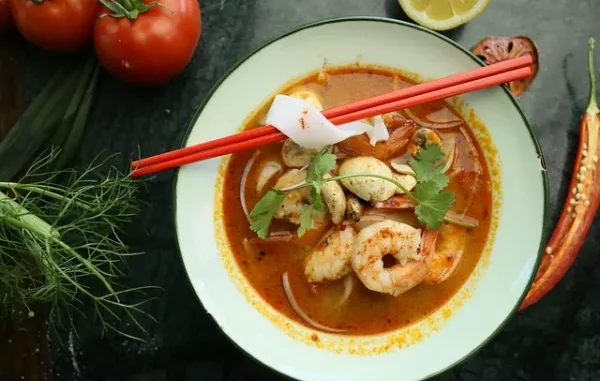
Noodles, a beloved staple of world cuisines, have a rich history dating back thousands of years. They come in various shapes and sizes, made from wheat, rice, buckwheat, or mung beans, offering endless meal possibilities. Additionally, noodles are a nutritious food choice, providing carbohydrates, essential vitamins, and minerals. Whether you prefer ramen, spaghetti, or cold noodles, the appeal of this food is undeniable. Here are some interesting facts about noodles.
10 Interesting Facts About Noodles
Ancient Origins: Noodles have a surprisingly long history, with evidence of their existence dating back over 4,000 years in China. The earliest noodles were likely made from millet flour, and they’ve evolved into the vast varieties we know and love today.
Global Staple: Noodles are a staple food in many cultures around the world, enjoyed in countless forms. From Asian ramen and pad thai to Italian spaghetti and German spätzle, noodles transcend geographical boundaries, offering a delicious and versatile food option.
Material Marvels: The ingredients used to make noodles are incredibly diverse. Wheat flour is a common base, but rice flour, buckwheat flour, and even mung bean starch can be used, creating noodles with distinct textures and flavors.
Longest Noodle Ever Made: If you thought your spaghetti portions were impressive, think again! In 2005, a team in China created the world’s longest noodle, measuring a staggering 4,051 meters (over 13,287 feet)!
Noodle Museums: Noodles are so beloved that they even have dedicated museums! The Cup Noodles Museum in Japan celebrates the instant noodle invention, while the National Ramen Museum in Yokohama offers visitors a deep dive into the world of ramen.
Slurping is Acceptable (Encouraged!): In some cultures, slurping your noodles is considered a sign of enjoyment and appreciation of the flavor. So, next time you’re savoring a bowl of ramen in Japan, don’t be shy – slurp away!
Space Noodles: Believe it or not, noodles have even reached outer space! Instant noodles were included in the Apollo 11 astronauts’ food supply, demonstrating their practicality and long shelf life.
More Than Just Food: Noodles can also be used for creative purposes beyond consumption. In China, a traditional art form called “miantiao hua” (noodle painting) involves arranging colorful noodles to create intricate designs.
Symbolism and Superstition: Noodles hold symbolic meaning in some cultures. In China, long noodles represent longevity, making them a popular dish for birthday celebrations. In Japan, slurping buckwheat noodles on New Year’s Eve is believed to bring good luck for the coming year.
Endless Variations: The beauty of noodles lies in their endless possibilities. With countless shapes, sizes, flavors, and cooking methods, there’s a noodle dish out there to tantalize every taste bud. So, next time you’re looking for a quick, delicious, and versatile meal, consider the humble noodle – a culinary marvel with a rich history and boundless potential.
The Origins of Instant Ramen: The History and Other Interesting Facts About Noodles
Instant ramen, a beloved convenience food enjoyed by many around the world, has a fascinating history that dates back to post-World War II Japan. The origins of this quick and easy meal can be traced back to Momofuku Ando, a Taiwanese-Japanese inventor who is credited with creating the first instant ramen noodles.
Ando’s inspiration came during a time of food scarcity in Japan, following the devastation of the war. He observed long lines of people waiting for a bowl of hot noodles, which sparked his idea to create a product that would provide a quick and affordable meal solution for the masses.
In 1958, after much experimentation and innovation, Ando introduced the world’s first instant ramen noodles under the brand name “Chikin Ramen.” The noodles were pre-cooked, dried, and packaged with a flavoring powder, allowing consumers to simply add hot water and enjoy a piping hot bowl of ramen in minutes.
The success of Chikin Ramen paved the way for Ando to further revolutionize the instant noodle industry. In 1971, he introduced Cup Noodles, the first instant ramen product to be packaged in a convenient cup, making it even easier for consumers to enjoy a quick and satisfying meal on the go.
Today, instant ramen has become a staple in households worldwide, with a wide variety of flavors and styles available to suit every palate. Despite its humble beginnings, instant ramen continues to be a popular choice for busy individuals looking for a delicious and convenient meal option.
Noodle Fun Facts: Did You Know Some Noodles Can Be Eaten Raw?

It’s true that some types of noodles can be eaten raw. For example, Japanese soba noodles are traditionally enjoyed both hot and cold and are often used raw in dishes like salads. Additionally, some Italian pasta dishes, such as pasta salads, include raw noodles mixed with other ingredients.
While raw noodles can be safe to eat, it’s important to be cautious of potential contamination. Make sure to use fresh, high-quality noodles and store them properly to prevent any risk of foodborne illness. Additionally, some people may find raw noodles difficult to digest, so it’s best to consume them in moderation.
Even though the idea of eating raw noodles may seem unusual to some, it’s a culinary practice enjoyed in various cuisines around the world. So, the next time you want a quick and easy meal, consider trying some raw noodles for a unique and tasty dining experience.
From Italy to Asia: A Cultural Exploration of Different Types of Noodles
Noodles are a staple food in many cultures around the world, and each region puts its own unique spin on this versatile dish. In this cultural exploration, we will focus on the diverse varieties of noodles found in Italy and Asia, and the cultural significance they hold in their respective regions.
Italian cuisine is renowned for its pasta, offering a wide range of shapes and sizes to choose from. From the long and slender spaghetti to the tube-shaped rigatoni, each type of pasta has its own purpose and is often paired with specific sauces and ingredients. One of the most iconic Italian noodles is the fettuccine, typically served with a creamy Alfredo sauce or a hearty Bolognese ragu. Another popular Italian noodle is the gnocchi, a soft and pillowy dumpling made from potato and flour, often served with a rich tomato sauce or a fragrant pesto.
Asian cuisine offers a wide variety of noodle types, each with its own unique texture and flavor. From the chewy Chinese egg noodles to the smooth rice noodles used in Vietnamese pho, Asian noodles come in diverse shapes and sizes. One of the most popular Asian noodles is Japanese ramen. It features a savory broth, tender noodles, and various toppings like sliced pork, soft-boiled eggs, and green onions. Another beloved Asian noodle dish is Thai pad Thai. This is a stir-fried noodle dish made with rice noodles, shrimp, tofu, and peanuts. The ingredients are then all tossed in a sweet and tangy sauce.
While Italian and Asian noodles may differ in their ingredients and preparation methods, they both share a common thread in their ability to bring people together and celebrate the rich culinary traditions of their respective cultures. Whether you’re twirling a forkful of spaghetti in Rome or slurping a steaming bowl of ramen in Tokyo, noodles serve as a delicious reminder of the diverse and vibrant tapestry of global cuisine.
The Science Behind the Perfectly Chewy Noodle: How Ingredients Impact Texture
Noodles are a beloved staple in many cuisines worldwide due to their versatility and ability to absorb flavors. The texture of noodles is greatly influenced by the ingredients used in their preparation. Creating the perfect chewy noodle involves understanding how these ingredients interact during the cooking process.
When making noodles, the key ingredients are flour, water, and eggs. The type of flour used affects the noodle’s texture, while water and egg ratios impact the final product.
Other ingredients, such as salt, oil, and baking soda, can also impact the texture of noodles. Salt enhances the flavor of the noodles and strengthens the gluten structure. Oil can add moisture and prevent sticking. Baking soda can help to tenderize the noodles and give them a smoother texture.
Noodle Facts: The World’s Longest Noodle and Other Guinness World Records

Noodles have been a staple food in many cultures for centuries. Their versatility and delicious taste have made them a popular choice for meals all around the world. But did you know that there are some fascinating Guinness World Records related to noodles? From the world’s longest noodle to the largest bowl of noodles, here are some noodle facts that will leave you in awe.
The world’s longest noodle was created in China in 2017, measuring an impressive 3,084 meters (10,119 feet) long. In addition, a restaurant in Japan set the record for the largest bowl of ramen noodles, weighing in at a whopping 2,982 pounds. Another interesting noodle-related record is the fastest time to eat a bowl of noodles, achieved in 41.12 seconds.
Noodles have a fascinating history and have become a staple food in many cultures around the world. From their origins in China to their global popularity today, noodles have evolved in countless shapes, sizes, and flavors. Whether served in a soup, stir-fry, or salad, noodles continue to be a versatile dish that brings people together. Next time you enjoy a bowl of noodles, remember the rich history behind this simple yet delicious food.






Hey Christopher
Your comment totally made me crave bun bo hue too! That lemongrass broth is just so flavorful. I haven’t tried making it from scratch yet, but there’s a great Vietnamese restaurant down the street from me that does an amazing version.
Lanzhou hand-pulled noodles sound incredible though! I love the element of performance in their preparation [LSI: Lanzhou hand-pulled noodles, performance aspect]. Maybe we could find a place that makes them around here, or be adventurous and try making them ourselves sometime?
This article has definitely got me thinking outside the box when it comes to noodles. Who knew there was such a rich world of noodle cultures to explore?
It’s incredible how such a simple food can have so many variations. The author’s point about knife-cut noodles versus hand-pulled noodles piqued my curiosity. I had no idea there were different methods for making noodles!
Now I’m hungry to try some regional noodle dishes from around the world. Maybe I can find a recipe for some Lanzhou hand-pulled noodles or some Vietnamese bun bo hue to try at home.
It’s definitely given me some noodle inspiration for future meals!
Wow, I never knew that about noodles!
This article was very interesting! Noodles are such a universal food, it’s amazing to think about all the history and variety that goes into them. The bit about different cultures having their own unique noodle broths was particularly interesting.
I’m also curious to try making some of the egg noodles from scratch at home like the article mentioned. I usually just buy dried noodles from the store, but it sounds like a fun challenge!
Thanks for sharing this article! It’s definitely made me appreciate noodles on a whole new level
I like reading about food in general and I also like a lot this blog. My other favorite blog is dazny.com